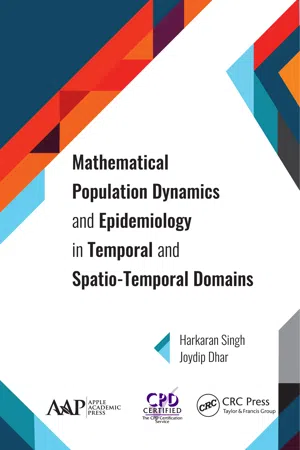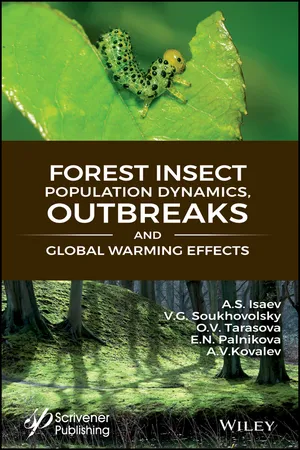Biological Sciences
Population Dynamics
Population dynamics refers to the study of how populations of organisms change over time. It involves examining factors such as birth rates, death rates, immigration, and emigration to understand population growth or decline. This field also explores the interactions between different species within a community and the impact of environmental factors on population size and distribution.
Written by Perlego with AI-assistance
Related key terms
4 Key excerpts on "Population Dynamics"
- eBook - ePub
- Harkaran Singh, Joydip Dhar(Authors)
- 2018(Publication Date)
- Apple Academic Press(Publisher)
Chapter 1Introduction and Mathematical Preliminaries
1.1 IntroductionMathematical biology, nowadays, is a well-known field, which is growing fast, being an interdisciplinary subject and undoubtedly, has been one of the most appealing applications of mathematics. The complexity of the biological sciences makes the interdisciplinary involvement essential. For the mathematicians, biology opens up numerous new branches, while, for the biologists, mathematical modeling offers another powerful research tool. Further, population biology and epidemiology is a fascinating domain of study in the field of biomathematics for today’s researchers. The increasing study of realistic and practically useful mathematical models in Population Dynamics and epidemics is a reflection of their use in helping to understand the dynamic processes involved therein and in making practical predictions [1 ].1.1.1 Population DynamicsA population is a group of individuals who live together in the same habitat and are likely to interbreed. It may contain individuals of different ages, and the age of an individual is likely to change over time.Further, the size of a population may grow or shrink depending on the biological and environmental parameters such as birth rates, death rates, immigration, and emigration. The study on these changes of age and size of a population is known as Population Dynamics. Some of the examples are population growth, population decline, and aging population. Also, for interpreting survey data and predicting pest outbreaks, a good under- standing of Population Dynamics is very much useful [2 –4 ].1.1.2 Prey-Predator InteractionsThe Population Dynamics of each species is affected when two or more species interact. There are three types of interactions among the species: (i) if the growth rate of one species is increasing and the others is decreasing, then they are in a prey-predator relationship; (ii) if the growth rate of each species is decreasing, then they are competing; and (iii) if the growth rate of each species is increasing, then they are in mutualism [5 ]. It is a well-known fact that the prey-predator interactions is a subject of great interest in the bio-mathematical literature starting with the pioneer work of Lotka [6 ] and Volterra [7 ], and the dynamic relationship between predator and prey living in the same environment will continue to be one of the important themes in mathematical ecology [8 , 9 ]. A number of mathematicians, in the past, have studied prey-predator models and contributed to their development and even today’s mathematicians are engaged in anticipating and understanding the diverse biological world of prey-predator systems [10 –18 - eBook - ePub
- Laurie Ann Callihan(Author)
- 2013(Publication Date)
- Research & Education Association(Publisher)
CHAPTER 7 Population Biology CHAPTER 7 POPULATION BIOLOGY ECOLOGYEcology is the study of how organisms interact with other organisms and how they influence or are influenced by their physical environment . The word “ecology” is derived from the Greek term oikos (meaning “home” or “place to live”) and ology (meaning “the study of ”), so ecology is a study of organisms in their home. This study has revealed a number of patterns and principles that help us understand how organisms relate to their environment. First, however, it is important to grasp some basic vocabulary used in ecology.The study of ecology centers on the ecosystem. An ecosystem is a group of populations found within a given locality, including the abiotic environment around those populations. A population is the total number of a single species of organism found in a given ecosystem. Typically, there are many populations of different species within a particular ecosystem. The term organism refers to an individual of a particular species. Each species is a distinct group of individuals that are able to interbreed (mate), producing viable offspring. Although species are defined by their ability to reproduce, they are usually described by their morphology (their anatomical features).Populations that interact with each other in a particular ecosystem are collectively termed a community . For instance, a temperate forest community includes pine trees, oaks, shrubs, lichen, mosses, ferns, squirrels, deer, insects, owls, bacteria, fungi, etc.The part of the Earth that includes all living things is called the biosphere . The biosphere also includes the atmosphere (air), the lithosphere (ground), and the hydrosphere (water).A habitat refers to the physical place where a species lives. A species’ habitat must include all the factors that will support its life and reproduction. These factors may be biotic (i.e., living—food source, predators, etc.) and abiotic - eBook - ePub
- Charles Krebs(Author)
- 2008(Publication Date)
- CSIRO PUBLISHING(Publisher)
Populations are dynamic. They grow and decline, and one important goal of ecology is to understand why. Growing populations are highly desirable if they are crop plants or fish that we want to harvest, but they can also be undesirable if they are pest species or disease organisms such as the anthrax bacterium. Population Dynamics is a quantitative subject—it requires us to calculate the rate at which populations change. But we can use graphs to illustrate the principles of population change without delving into the underlying mathematics. Let us start our analysis with a simple model of how a population might increase over time. We will then look at patterns of population change over time in nature.Geometric Population Growth
Imagine a population that has been released into a favorable environment and begins to increase in numbers. What forms will this increase take, and how can we describe it quantitatively? To begin, let us consider the simple case in which generations are separate, as in annual plants, which have a single breeding season and a lifespan of one year. What happens to this population will depend on the number of female offspring that survive and reproduce the following year (see Essay 6.1 ). The pattern of population change is called geometric population growth (or exponential growth) because, in the simplest case, the population grows like the geometric series 1, 2, 4, 8, 16, 32, 64, and so on.Figure 6.1 shows some examples of geometric population growth in which different numbers of female offspring are produced in each generation. As you would expect, the more female offspring that are produced, the more rapidly the population increases. This is exactly the way money grows in a bank account with a constant annual rate of interest.However, populations do not continue to grow geometrically as in Figure 6.1. If they did, the world would be stacked high with elephants and oak trees. Aristotle pointed this out 2,300 years ago, and Darwin repeated it 150 years ago. Therefore, we must modify the geometric model to take into account the fact that all populations eventually stop growing.Figure 6.1. Geometric population growth in a hypothetical species of annual plant that has a constant reproductive rate. The four curves show how the growth rate depends on the average number of female offspring produced per generation (1.05, 1.10, 1.15 and 1.20). Each population begins with 10 females at generation 0. - A. S. Isaev, Vladislav G. Soukhovolsky, O. V. Tarasova, E. N. Palnikova, A. V. Kovalev(Authors)
- 2017(Publication Date)
- Wiley-Scrivener(Publisher)
Another approach is to develop models of intra-population interactions of insects and the influence of food and natural enemies on their density. These models are based on different types of differential equations, and analysis of these equations reveals different types of Population Dynamics. The choice of functions describing these interactions, however, may be quite arbitrary, as the models do not restrict this choice. Moreover, these models usually assume that model parameters are time invariant. If this assumption is invalidated, analysis of the models becomes very difficult.A third approach to analysis of phytophagous insect Population Dynamics is based on using phase portraits and identifying characteristic parameters that reflect interactions in a forest ecosystem (Isaev, Khlebopros, 1973; Isaev et al., 1984; Isaev et al., 2001; Isaev et al., 2009). By employing this approach, one can study not only different forms of population density regulation but also regulatory mechanisms of the entire ecological system, its stability and delays, positive and negative feedbacks, the ranges of the parameter values for certain effects, dimensions of the phase portraits and their qualitative content. Furthermore, there is no need to evaluate parameters of the forest ecosystem as influenced by specific environmental factors.Specific interactions between plants and insects in the forest ecosystem are manifested as a combination of continuous and discrete processes. Insect Population Dynamics is characterized by synchronous generations and discrete vital processes. As the insect life cycle is “short” (one or two years) relative to the “long” process of the ecosystem change (decades and centuries), insect Population Dynamics can be studied in terms of continuous systems.The simplest models used for analysis are regression models, in which Population Dynamics is described by some function of time F(t) of a certain linear or nonlinear form, and coefficients of this function are calculated by using methods of regression analysis (Biging et al., 1980; Campbell, Sloan, 1978a,b). If F(t
Learn about this page
Index pages curate the most relevant extracts from our library of academic textbooks. They’ve been created using an in-house natural language model (NLM), each adding context and meaning to key research topics.



